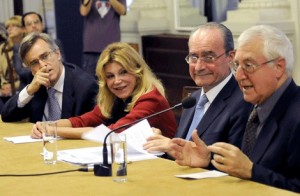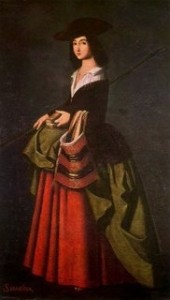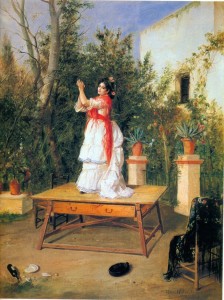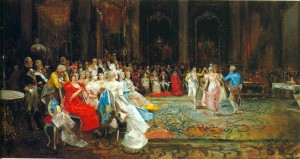November, 2009
Sunday, November 29th, 2009
| In today’s article on the forthcoming trial of John Demjanjuk, alleged participator in Jewish mass murders, Wolfgang Benz, head of the Centre for Anti-Semitism Research at the Technical University of Berlin, is quoted as being enthusiastic about the trial as he believes that ‘dealing with [Germany’s Nazi] past is extremely important’, even if the aforementioned Demjanjuk is only ‘a small cog’. Unfortunately Wolfgang Benz is less enthusiastic when it comes to dealing with the ‘big cogs’. When I wrote a feature in Frankfurter Allgemeine Zeitung concerning Heini Thyssen’s sister’s involvement in the slaughter of 180 Hungarian Jews at a party at their Austrian castle in Rechnitz in 1945, Wolfgang Benz immediately lept to her defence by denying the event ever took place. Even various German journalists, embarrassed by his denial, admitted that it wasn’t the first time that he had made such a questionable comment. |
 'Nazi Denialist' Wolfgang Benz |
Tags: Frankfurter Allgemeine Zeitung, Heini Thyssen, John Demjanjuk, Nazi Atrocity, Rechnitz, Sunday Telegraph, Technical University Berlin, Wolfgang Benz
Posted in The Thyssen Art Macabre, Thyssen Corporate, Thyssen Family Comments Off on Sunday Telegraph Quotes Nazi Atrocity ‘Denialist’ Wolfgang Benz
Saturday, November 28th, 2009
| The Argentinean actor, director and professor of drama, Ernesto Beltran Meza, writes on his blog (following a recent article in El Mundo):
La “guerra de los Thyssen” pone en alerta al mundo del arte
Las “Lágrimas de Eros” atraen estos días a miles de personas al Museo Thyssen-Bornemisza de Madrid. La exposición, un recorrido por el erotismo en la historia del arte, es todo un éxito. Lo que pocos visitantes saben es que detrás de la fachada del Palacio de Villahermosa, el edificio neoclásico que alberga a la pinacoteca, se libra una dura batalla por el legado de la familia que da nombre a una de las colecciones de arte más importantes del mundo. Esta batalla, que ya ha llegado a los tribunales, sí que ha hecho correr lágrimas, pero de ira y dolor, además de poner en peligro el futuro de ese patrimonio cultural.
Por un lado está Carmen “Tita” Cervera, ex “Miss España” y viuda del barón Hans-Heinrich Thyssen-Bornemisza, un acaudalado industrial y mecenas de nacionalidad suiza y origen húngaro-alemán que en 1992 vendió al Estado español su impresionante colección de 800 obras de arte por 400 millones de euros.
Por el otro está Borja, 29 años, el hijo de Carmen, fruto de una relación anterior a su matrimonio con el barón. Éste lo acogió como un hijo más y le dio su apellido. El joven afirma haber descubierto que es cobeneficiario de la colección de arte de su madre, compuesta por alrededor de 1.000 obras. Las piezas están valoradas nada menos en 800 millones de euros.
Cervera, que a sus 66 años es vicepresidenta del patronato de la Fundación Thyssen, demandó a su hijo ante tribunales, acusándolos de revelación de secretos y sustracción de documentos. Mientras que Borja reclama dinero, su madre intenta preservar su colección. Ésta incluye piezas fundamentales del arte moderno, además de importantes obras de Courbet, Corot, Monet, Pissarro, Sisley, Renoir, Degas, Gauguin, Braque, Matisse, entre otros.
So, I blogged him:
‘Dear Ernesto
Please forgive my writing to you in English, but my Spanish is not good enough.
I don’t mean to piss on your parade and it might sound to some as if I’m on a mission of hatred. I’m not. I got to know Heini and Tita Thyssen very well and liked them both (Tita is thought by many to be round the bend and a pain in the bum, but nonetheless, I like her).
Please don’t perpetuate stereotypical Thyssen myths. Heini’s forebears, and in particular his fortune, came from Germany. It was created by Old August Thyssen and thousands of dedicated, hard-working coal and steel workers. Switzerland and Hungary were merely conveniences.
While Heini’s collection is very impressive, it isn’t all it is said to be. Many art experts know that it contains many forgeries and paintings of a questionable provenance. It is also rather directionless, with no central theme and even where works are by genuine masters, they are mostly second-rate examples of their work.
The money for the collection, apart from that made by Old August, also includes profits from two world wars and the Thyssens’ involvement with the Nazi Party. It is not a background that gives any reason for pride.
The Thyssens have never been art ‘patrons’. They bought art; they did not pay artists to create it. They used art as a tax-efficient investment and a means of cloaking their past.
As far as Tita’s collection is concerned, while I admire the fact she has a personal taste, hers cannot, by any stretch of the imagination, be described as great art, and is certainly not worth, particularly in today’s climate, 800 million Euros, especially not to the Spanish, who have already paid for one Thyssen-Bornemisza Collection. They need two Thyssen-Bornemisza Collections like a hole in the head.
However, if you disagree with anything I say, there is always the option of your country renting Tita’s collection. I’m sure she would be delighted.’
Ernesto’s Blog has been going since 1987! |
 Ernesto Beltran Meza, ACTOR, DIRECTOR y PROFESOR DE TEATRO, egresado de Escuela Teatro La Plata, dependiente de DGCyE Pcia Bs As y PROFESOR DE ARTE EN TEATRO (Complementación Curricular de Grado) IUNA BUENOS AIRES - |
Tags: August Thyssen, Borja Thyssen, Carmen Tita Cervera, Degas, El Mundo, Ernesto Beltran Meza, Fundacion Thyssen, Gauguin, Hans Heinrich Thyssen, Lagrimas de Eros, Museo Thyssen-Bornemisza, Nazi Party, Palacio de Villahermosa, Pissarro
Posted in The Thyssen Art Macabre, Thyssen Art Comments Off on ThyssenArt Argentina
Saturday, November 28th, 2009
| On the night of 27 November 2009, Francesca Habsburg (nee Thyssen) gave a party to celebrate her gold medal award by the county of Vienna, for her services to art. To present the niece of Margit Batthyany (nee Thyssen), owner of Rechnitz Castle and hostess of the party in March 1945 during which 180 Hungarian Jews were murdered, with a gold medal, while the investigations are ongoing, is, in my opinion, extremely questionable. But for Francesca to indicate on her invitation that she expects her guests to come ‘DRESSED TO KILL’ is more than a step too far. Let us hope that it is purely the result of her arrogance and thoughtlessness, rather than some insulting gesture to the memory of the victims of the Rechnitz Massacre.
Unfortunately, I cannot voice my reaction as explicitly as I would like, for legal reasons. Interestingly, some of the Austrian commentators were also less than impressed:
23. November 2009, 17:08 (Andrea Schurian, DER STANDARD Printausgabe 24.11.2009)
‘Eine Frage der Ehre (Verdienstvolle Zeichen)
Wien preist seine ehrenwerten Bürgerinnen und Bürger in sieben Abstufungen; da gibt es Halsdekorationen mit und ohne Bruststernen; nur Bruststerne. Oder, in den hinteren Rängen: Medaillen. Das Goldene Verdienstzeichen des Landes Wien ist eine Medaille mit goldenen Strahlen, vergeben für große Verdienste. Danach kommt nur mehr Silber. Alles klar so weit.
Am Donnerstag vergoldet Wien der Kunstmäzenin Francesca Habsburg-Lothringen, née Thyssen- Bornemisza, ihre großen Verdienste mit einer solchen Medaille. Mit ihrer Kunststiftung namens T-B A21 tut sie viel für die Kunst – und die Künstler (mitunter auch die öffentliche Hand) viel für sie und ihren Ruhm.
Kurzum: Alles sehr verdienstvoll. Auch die superlative Goldmedaillen-Party alias DJ-Battle alias Wohltätigkeits-Event: sehr ehrenvoll. Eintritt für einfache Charity-Dancer von 50 Euro aufwärts, einen Zehnpersonentisch gibt es für minimum 1000 Mäuse. Klamottencode: Dressed to kill. Auch klar.
Nur das mit der Location war nicht so ganz klar. Das Mak [Museum für angewandte Kunst] werde Schauplatz der DJ-Sause, hieß es im Profil. Aber Peter Noever wollte nicht so gut sein und das Museum gratis zur Verfügung stellen. Weil: warum? Und zu wessen höherer Ehre?
Andererseits: Wie kann man sich denn so richtig toll fühlen, wenn es die anderen nicht so gut mit einem meinen? Die Party findet nun in der Ankerbrotfabrik statt. Eine Frage der Ehre. Klar.’ |
 Mrs Habsburg |
Tags: Andrea Schurian, Ankerbrotfabrik, Charity, Der Standard, DJ-Battle, Dressed To Kill, Francesca Habsburg, Goldenes Verdienstzeichen, Hungarian Jews, Land Wien, Margit Batthyany, Museum für angewandte Kunst, Peter Noever, Profil, Rechnitz Castle, Rechnitz Massacre, T-B A21, Thyssen, Thyssen-Bornemisza
Posted in The Thyssen Art Macabre, Thyssen Family Comments Off on ‘Killing’ Thyssen Party
Tuesday, November 10th, 2009
| As the ravenous ThyssenArt Beast proceeded to eat its way through Malaga’s hot, sleepless nights, the Board of the Museo Carmen Thyssen-Bornemisza Foundation met for the very first time, presided over by ‘Our Precious Lady Carmen of The ChaChaCha’.
It seemed fitting for such a splendid occasion that it occurred in the town’s ‘Great Hall of Smoke and Mirrors’, which glittered proudly for ‘Carmen The Accumulator’s’ reunion with Vice-Presidente Francisco de la Torre (conservative mayor of Malaga), councillors Miguel Briones, Mariluz Reguero and Pedro Moreno Brenes, Tomas Llorens (former director of the Museo Thyssen Madrid), Guillermo Solana (current director of the Museo Thyssen Madrid) and one Teresa Sauret Guerrero. Only the identity of the other three members of the eleven-strong MCTBF board remained shrouded in deepest mystery.
Now, for some time, the unruly Izquierda Unida and their friends had been the lone ‘voice in the wilderness’, most un-‘preciously’ questioning the wisdom of spending tens of millions of Euros of taxpayers’ money on refurbishing crumbling provincial palaces to create more Thyssen Museums, bearing in mind that the Thyssens’ ‘precious’ immortality had already been subsidised in the country’s capital for twenty years to the tune of some 500 million Euros.
The main concern was the question of how many and exactly which of ‘The Baroness’s’ 1000 paintings – valued by The Great Art Expert herself at 800 million very ‘precious’ Euros – would eventually be housed in the new great institution. The only words crossing Her Magnificence’s own rose-scented lips was that they would all be ‘very nice’ and ‘very…..precious’, a view shared whole-heartily by the other defenders of The ThyssenArt Beast, all of them interested parties in their own ‘precious’ ways.
And so, as Mayor de la Torre opened the day’s proceedings, it looked like any remaining dissent could finally be quelled once and for all, when the solemn declaration was made that there would be not one but…..EIGHT (!) collections at the Carmen Thyssen-Bornemisza Museum in Malaga, and that these would comprise ‘romantic landscapes’, ‘naturalist landscapes’, ‘naval paintings’, ‘old masters’, ‘pictures from between the centuries from Tradition to The Renovation’, ‘portraits of Andalucia and Spain’, ‘costumbrism’, and, finally…..: ‘PRECIOUSCISM’!
Unwaware that this was just a word created during a game of scrabble between Guillermo Skywalker and Anikin Rosenthal, the common folk at once began to cheer uncontrollably. Men threw their hats in the air and women frantically fanned their flushed cheeks, while everyone whooped and hollered in manic delight: ‘It’s a miracle! My God, a miracle! What a great Baroness she is, Our Lady ChaChaCha. She is so beautiful and so good to us! We are so utterly greateful to her! Long may she live! Long may she live!‘.
Indescribable scenes of sheer, ‘precious’ ecstasy ensued, the crowd chanting ‘Pre-cious! Pre-cious! Pre-cious! Pre-cious!’ until their voices grew hoarse.
Finally, The ThyssenArt Beast’s old Jedi Master, Yoda Llorens, managed to regain control over the hysterial mob and delivered his coup de grace: the museum’s Mission Statement. Apparently it was ‘the intention of the museographic contents of the new art centre’….‘to mould a picture of Spanish society, and of that of Andalusia in particular, beginning with the romantic period and stretching through to the begining of the 20th century’.
Here the breath of the common folk was held for some time as they struggled to grasp the true meaning of the Jedi Master’s wise words. Stunned silence pervaded the air, until, out of the blue, one lone voice of dissent, Al Panpan, spoke out: ‘This picture of Andalusia which you are planning to ‘mould’, is a manipulative and unreal picture which was constructed from afar and represents the starting point of all the problems that came crushing down on us in the 20th century. I propose that Carmen Cervera inaugurate her new little museum wearing flamenco flounces and that the mayor joins her dressed up as The Joker’.
Security pounced at once, bundled up the obviously insane lone critic and quickly ushered him off to an uncertain future, but dark clouds began to gather, as great thunder rolled and lightening flashed, threatening to shatter the multitude of ‘precious’ mirrors. Suddenly, the form of ‘Borja, The Great Mighty Heir’ filled the doorway, lit by a single shaft of ghostly light. Terror descended. The people shivered with fear. Pausing, ‘The Great Mighty Heir’, with his inimitable stutter (a sure sign of true aristocratic breeding) began to read out passages from Hola Magazine, that most ‘precious’ of avant-garde gazettes: ‘G-g-gggg Gggigive me my Dddddog, my Dodododgy Ggggg-Goya. This is my uneq- eq- eqqqqq, un-eq, my un-eqqqqquiqui-, my uneqqqqui-vocal right!’, he finally roared in his booming voice.
It was later said that at this exact, precious moment in time, The King, who was not present but many hundreds of miles away, felt a sharp pain in his side and began to fear the worst for his magnificent, ‘precious’ friend, Tita Thyssen, and lo he was grieved!!
Sensing The King’s grief in reverse telepathy, the people started shouting: ‘Go home, Great Mighty Heir! Sling it! Get a job! And don’t you dare touch OUR precious paintings! They are OUR precious paintings, do you understand??!!’
And with a last whimpering roll of thunder he was gone.
The Great Impressionables had spoken. And so it was that The Great Accumulator’s ‘precious’ paintings were saved for the Spanish nation forever. Or as long as the Four Amigos can keep reaching deep into the wallets of the precious people of Spain. |
 The Four Amigos: Guillermo 'Skywalker' Solana, 'Carmen The Accumulator', Francisco 'The Joker' de la Torre and Tomas 'Great Jedi Master Yoda' Llorens, addressing the people of Malaga on 21 October 2009  The Dodgy Goya.  Another Dodgy Painting: Allegedly a 'Santa Marina' by Francisco de Zurbaran. Soon to be housed at the Carmen Thyssen-Bornemisza Museum in Malaga?  The Lady Dances (Manuel Cabral Aguado Bejarano, 1889)  Dances At The Palace (Eugenio Lucas Villamil, 1894)
|
Tags: Carmen Cervera, Francisco de la Torre, Guillermo Solana, Hola Magazine, Izquierda Unida, Malaga, Mariluz Reguero, Miguel Briones, Museo Carmen Thyssen-Bornemisza, Pedro Moreno Briones, Preciosismo, Teresa Sauret Guerrero, The ThyssenArt Beast, Tita Thyssen, Tomas Llorens
Posted in The Thyssen Art Macabre, Thyssen Art Comments Off on Preciosismo: A Fairy Tale Of Modern Spain (by The Great Collaborator)
|









